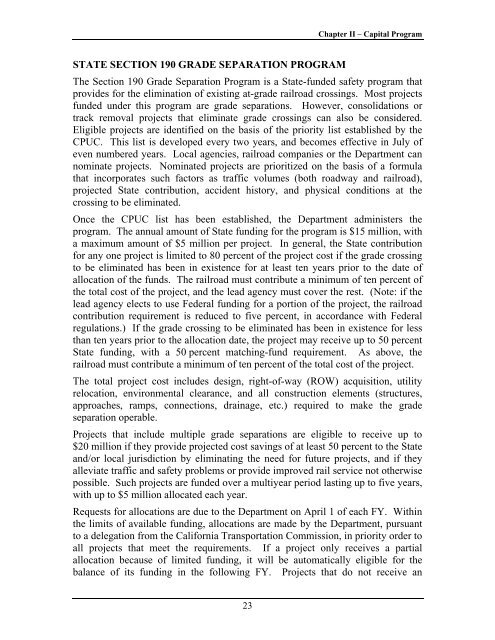California State Rail Plan 2005-06 to 2015-16
California State Rail Plan 2005-06 to 2015-16
California State Rail Plan 2005-06 to 2015-16
You also want an ePaper? Increase the reach of your titles
YUMPU automatically turns print PDFs into web optimized ePapers that Google loves.
Chapter II – Capital Program<br />
STATE SECTION 190 GRADE SEPARATION PROGRAM<br />
The Section 190 Grade Separation Program is a <strong>State</strong>-funded safety program that<br />
provides for the elimination of existing at-grade railroad crossings. Most projects<br />
funded under this program are grade separations. However, consolidations or<br />
track removal projects that eliminate grade crossings can also be considered.<br />
Eligible projects are identified on the basis of the priority list established by the<br />
CPUC. This list is developed every two years, and becomes effective in July of<br />
even numbered years. Local agencies, railroad companies or the Department can<br />
nominate projects. Nominated projects are prioritized on the basis of a formula<br />
that incorporates such fac<strong>to</strong>rs as traffic volumes (both roadway and railroad),<br />
projected <strong>State</strong> contribution, accident his<strong>to</strong>ry, and physical conditions at the<br />
crossing <strong>to</strong> be eliminated.<br />
Once the CPUC list has been established, the Department administers the<br />
program. The annual amount of <strong>State</strong> funding for the program is $15 million, with<br />
a maximum amount of $5 million per project. In general, the <strong>State</strong> contribution<br />
for any one project is limited <strong>to</strong> 80 percent of the project cost if the grade crossing<br />
<strong>to</strong> be eliminated has been in existence for at least ten years prior <strong>to</strong> the date of<br />
allocation of the funds. The railroad must contribute a minimum of ten percent of<br />
the <strong>to</strong>tal cost of the project, and the lead agency must cover the rest. (Note: if the<br />
lead agency elects <strong>to</strong> use Federal funding for a portion of the project, the railroad<br />
contribution requirement is reduced <strong>to</strong> five percent, in accordance with Federal<br />
regulations.) If the grade crossing <strong>to</strong> be eliminated has been in existence for less<br />
than ten years prior <strong>to</strong> the allocation date, the project may receive up <strong>to</strong> 50 percent<br />
<strong>State</strong> funding, with a 50 percent matching-fund requirement. As above, the<br />
railroad must contribute a minimum of ten percent of the <strong>to</strong>tal cost of the project.<br />
The <strong>to</strong>tal project cost includes design, right-of-way (ROW) acquisition, utility<br />
relocation, environmental clearance, and all construction elements (structures,<br />
approaches, ramps, connections, drainage, etc.) required <strong>to</strong> make the grade<br />
separation operable.<br />
Projects that include multiple grade separations are eligible <strong>to</strong> receive up <strong>to</strong><br />
$20 million if they provide projected cost savings of at least 50 percent <strong>to</strong> the <strong>State</strong><br />
and/or local jurisdiction by eliminating the need for future projects, and if they<br />
alleviate traffic and safety problems or provide improved rail service not otherwise<br />
possible. Such projects are funded over a multiyear period lasting up <strong>to</strong> five years,<br />
with up <strong>to</strong> $5 million allocated each year.<br />
Requests for allocations are due <strong>to</strong> the Department on April 1 of each FY. Within<br />
the limits of available funding, allocations are made by the Department, pursuant<br />
<strong>to</strong> a delegation from the <strong>California</strong> Transportation Commission, in priority order <strong>to</strong><br />
all projects that meet the requirements. If a project only receives a partial<br />
allocation because of limited funding, it will be au<strong>to</strong>matically eligible for the<br />
balance of its funding in the following FY. Projects that do not receive an<br />
23













